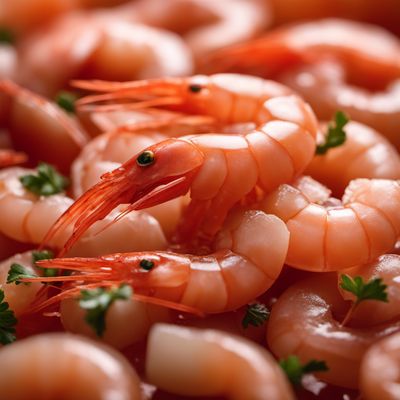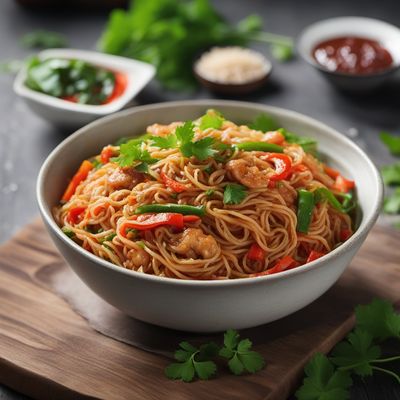
Ingredient
Crustaceans
The Ocean's Delicacy: Crustaceans
Crustaceans are characterized by their hard exoskeletons and jointed limbs. They inhabit various aquatic environments, from oceans to freshwater lakes and rivers. Crustaceans have a wide range of flavors and textures, depending on the species. Lobster meat is tender and sweet, while crab meat is delicate and slightly briny. Shrimp have a firm and slightly sweet flesh, while crayfish have a more delicate and slightly earthy flavor. Crustaceans are commonly used in a variety of dishes, including soups, stews, pasta, and seafood boils.
Origins and history
Crustaceans have been consumed by humans for thousands of years. They have played a significant role in coastal cuisines around the world, particularly in regions with abundant seafood resources. Crustaceans were highly valued by ancient civilizations, such as the Egyptians and the Romans, and they continue to be a sought-after delicacy in modern times.
Nutritional information
Crustaceans are a good source of lean protein and essential minerals like selenium and zinc. They are low in fat and calories, making them a healthy choice for seafood enthusiasts. However, individuals with shellfish allergies should avoid consuming crustaceans, as they can trigger severe allergic reactions.
Allergens
May cause allergic reactions in individuals with shellfish allergies.
How to select
When purchasing crustaceans, look for specimens that are alive or freshly caught. Live crustaceans should be active and show signs of movement, such as twitching legs or flapping tails. Freshly caught crustaceans should have a vibrant color and a mild oceanic smell. Avoid crustaceans with a strong ammonia odor or signs of spoilage, such as slimy shells or discolored meat.
Storage recommendations
To maintain the freshness and quality of crustaceans, store them in a cool environment, such as a refrigerator or an ice-filled cooler. Keep them alive until ready to cook by placing them in a container with damp newspaper or seaweed. Cooked crustaceans should be consumed immediately or stored in the refrigerator for up to two days.
How to produce
Crustaceans are typically harvested from the wild or farmed in aquaculture facilities. They require specific environmental conditions to thrive, such as clean water and appropriate temperatures. Crustacean farming involves raising the animals in controlled environments and providing them with a balanced diet. However, due to the complexity of crustacean farming, it is best left to professional aquaculturists.
Preparation tips
Crustaceans can be prepared in various ways, depending on the species. Lobsters and crabs are often boiled or steamed and served with melted butter or a flavorful sauce. Shrimp can be grilled, sautéed, or used in stir-fries and pasta dishes. Crayfish are commonly boiled or used in Cajun-style dishes like étouffée or jambalaya. The meat can be extracted from the shells and used in salads, sandwiches, or seafood soups.
Culinary uses
Crustaceans are widely used in cuisines around the world, particularly in coastal regions. They are commonly featured in dishes like lobster bisque, crab cakes, shrimp scampi, and crayfish boils. Crustaceans are also a popular choice for sushi and sashimi in Japanese cuisine.
Availability
Commonly available in coastal regions and areas with access to fresh or frozen seafood.
More ingredients from this category

Freshwater crustaceans
Delicate Aquatic Gems

King crabs, squat-lobsters
Majestic Crustaceans: King Crabs and Squat-Lobsters

Shrimps and prawns
Delicious Crustaceans

Lobsters, spiny-rock lobster
Spiny-Rock Lobster: The Delicacy from the Sea

Krill, planktonic crustaceans
The Tiny Marvels of the Ocean: Unveiling the World of Krill

Miscellaneous marine crustaceans
Oceanic Delicacies

Crabs, sea-spiders
Delicacies from the Deep: Exploring the World of Crabs and Sea-Spiders
Recipes using Crustaceans

Burundian-inspired Cheesecake with Local Flavors
Umugati Cheesecake: A Fusion of Burundian and Creamy Delights

New York-Style Cheesecake
Decadent Delight: Haute Cuisine Cheesecake

Moroccan-Inspired Cheesecake
Spiced Delight: Moroccan-Inspired Cheesecake

Liaoning-style Crispy Noodle Delight
Golden Crunch: Liaoning-inspired Crispy Noodle Delight